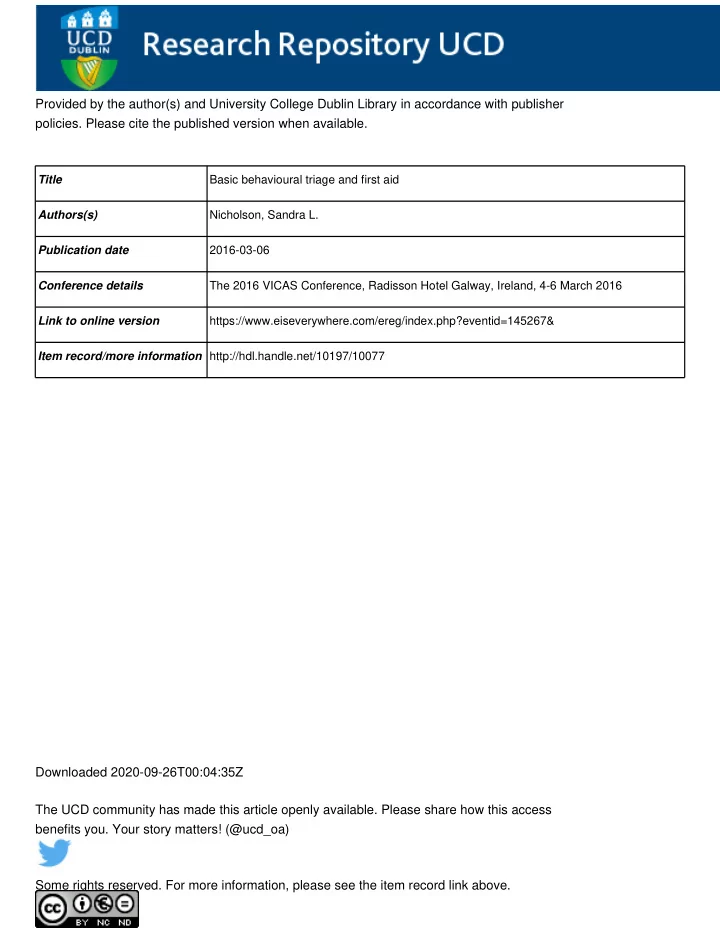

Provided by the author(s) and University College Dublin Library in accordance with publisher policies. Please cite the published version when available. Title Basic behavioural triage and first aid Authors(s) Nicholson, Sandra L. Publication date 2016-03-06 Conference details The 2016 VICAS Conference, Radisson Hotel Galway, Ireland, 4-6 March 2016 Link to online version https://www.eiseverywhere.com/ereg/index.php?eventid=145267& Item record/more information http://hdl.handle.net/10197/10077 Downloaded 2020-09-26T00:04:35Z The UCD community has made this article openly available. Please share how this access benefits you. Your story matters! (@ucd_oa) Some rights reserved. For more information, please see the item record link above.
“ Basic behavioural triage and first aid” Sandra Nicholson, VICAS 2016, Presentation 1 abstract/summary Responsibilities of vet nurse in behavioural issues When a pet has behavioural issues, the client often seeks advice from many different sources before approaching the veterinary practice for advice. This may be because they are not aware that veterinary staff can assist with behavioural problems (Martin et al. , 2014). In order to create awareness of the role of veterinary practice staff in managing animal behaviour, it is important that behaviour is discussed from the client’s first visit to the practice and then routinely throughout the animal’s life (Martin et al ., 2014). However, many veterinary personnel are uncomfortable with giving advice on behavioural problems. As members of a caring profession, staff may hold very high expectations of themselves, translating into an “all or nothing” approach to behaviour. To protect animal welfare, it is important to readjust these self- expectations. In first-opinion practice, what roles and responsibilities can veterinary nurses assume in behavioural management? Veterinary personnel have a central role in preventing behavioural problems though the provision of advice and support and the running of “puppy parties” (Luescher et al., 2007; Landsberg et al ., 2008). When behavioural problems occur, it is imperative to determine their severity, in order to provide advice and/or refer to the appropriate person (Behavioural triage) (Luescher et al., 2007; Landsberg et al ., 2008). In addition, it is essential to provide interim management advice for animals with behavioural issues, in order to prevent the problem from worsening and to protect the animal and others from harm (Behavioural first aid) (Luescher et al., 2007; Landsberg et al ., 2008). It is not necessary to perform behaviour counselling or behaviour modification. Indeed, it would be unwise to attempt this without having received supplementary training in this area. In addition, behaviour counselling requires a heavy time input, which makes it impractical for many veterinary businesses to offer. Behavioural triage and First aid In order to accurately triage behavioural problems and provide “first aid” advice, a capsule history should be taken. The client should be asked to describe the problem in detail (Seibert and Landsberg, 2008). From this, the severity, context, triggers and functions of the behaviour can be determined (Seibert and Landsberg, 2008). It is also important to establish how long the problem has existed and how frequently the behaviour occurs, as this can influence the success of intervention (Martin et al. , 2014). Also, the client should be asked how they feel about the problem, as this can give an indication of the urgency of the issue (Martin et al. , 2014). Any existing health problems and current medications (including non-prescription items) must be identified and the animal referred for a health check (Seibert and Landsberg, 2008). It is helpful to categorise the problem as a normal but misunderstood behaviour, a training issue, or a true pathological behaviour. For normal behaviour, education will be required (Landsberg et al ., 2008). Unruly behaviours may need referral to a reliable trainer (Landsberg et al. , 2008). However, pathological behaviours will require referral to a suitably qualified and experienced behaviourist or veterinary behaviourist (Landsberg et al. ,
2008). Referral to a behaviourist may also be needed if there is strain on the human-animal relationship, risk of injury, an inability to avoid triggers/contexts, or high levels of animal stress (Martin et al. , 2014). Due to the complexity of the cases and/or their associated risks, issues involving aggression, anxiety, fear/phobia, persistent barking or compulsive behaviour should be referred to a behaviourist. For behavioural cases awaiting referral, there are a number of recommendations that can be made. Firstly, it is crucial to avoid the target and triggering context(s) (Horwitz, 2008; Martin et al. , 2014). This safeguards all individuals involved and will prevent the behaviour from worsening (Horwitz, 2008). Positive punishment should be stopped, as this can increase stress and worsen behavioural problems (Martin et al. , 2014). However, it is inadvisable to reward undesirable behaviour. Conversely, remind your client to reward desirable behaviours. Animal stress/anxiety should be reduced, where possible. Finally, environmental changes or changes in routine may be implemented to manage the problem behaviour. Conclusions Veterinary nurses have an active role to play in the prevention of behavioural problems and the first response to behavioural issues. The severity of behavioural problems should be determined and the case should be referred appropriately, if needed. While awaiting referral, advice on maintaining safety and managing the animal can be extremely beneficial. References Horwitz, D.F. (2008) ‘Managing Pets with Behavior Problems: Realistic Expectations.’ Veterinary Clinics of North America: Small Animal Practice 38 pp. 1005-1021 Landsberg, G.M., Shaw, J. and Donaldson, J. (2008) ‘Handling Behavior problems in the Practice Setting.’ Veterinary Clinics of North America: Small Animal Practice 38 pp. 951-969 Luescher, A.U., Flannigan, G., Frank, D. and Mertens, P. (2007) ‘The role and responsibilities of behaviour technicians in behavioural treatment and therapy.’ Journal of Veterinary Behavior 2 pp. 23-25 Martin, K.M., Martin, D. and Shaw, J.K. (2014) ‘Small Animal Behavioral Triage: A Guide for Practitioners.’ Veterinary Clinics of North America: Small Animal Practice 44 pp. 379-399 Seibert, L.M. and Landsberg, G.M. (2008) ‘Diagnosis and Management of Patients Presenting with Behavior problems.’ Veterinary Clinics of North America: Small Animal Practice 38 pp. 937-950
Recommend
More recommend